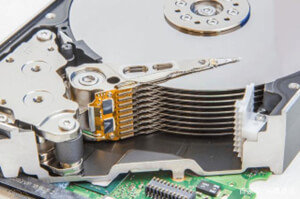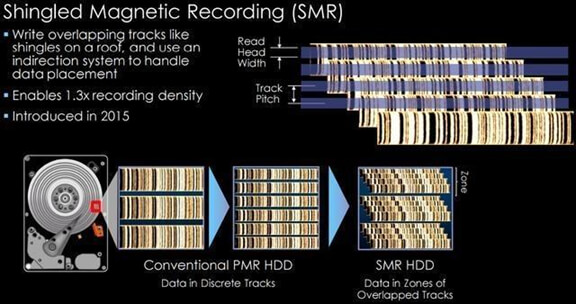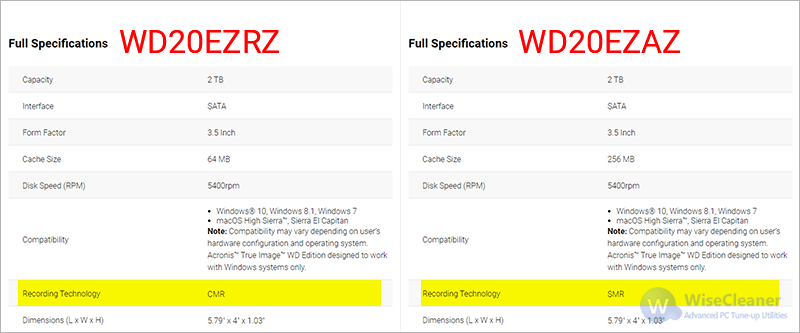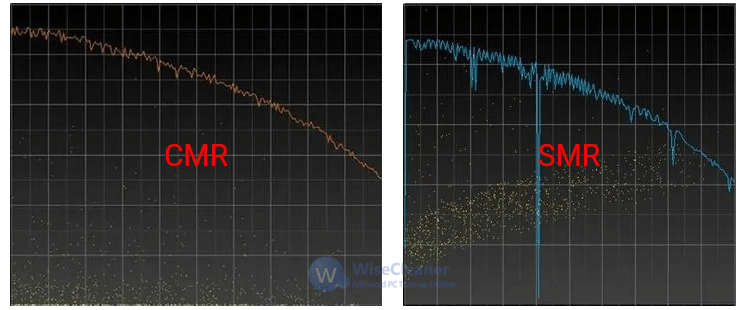WiseCleaner Think Tank
Encounter difficult computer problems?
All about maintenance and optimization of your Windows System.
Feb 20, 2023
Although SSD has now become the mainstream storage device due to its performance and gradually decreasing cost advantages, HDD still occupies a place in some usage scenarios due to its large capacity and lower price, such as being used as a warehouse disk, building a NAS, etc.
At the same time, after a long period of development, there are different types of hard disks due to differences in technology. The hard disks on the market are divided into CMR and SMR, and although they look the same on the surface, the actual user experience is different.

LMR refers to Longitudinal magnetic recording. It is the way of recording data used by the early hard disk. Because the magnetic particles are placed horizontally and have low density, they can only store very little data, and the capacity of a single disk is only 160GB.
With the explosive growth of data, this capacity quickly becomes stretched. There are three ways to increase the overall capacity of a hard disk.
The first two methods will inevitably increase the overall size of the hard disk, and any increase or decrease may bring adverse effects. Furthermore, the larger the disk in the hard disk, the better. The larger the disk, the greater the inertia when rotating at high speed, and the lower the stability, so the speed of the disk cannot be increased.
Therefore, the best way to increase hard disk capacity seems to be to increase the density of data storage on a single disk.
PMR refers to perpendicular magnetic recording. On the basis of LMR, PMR changes the horizontally placed magnetic particles into vertically placed ones. With the help of PMR technology, the storage capacity of the hard disk has been dramatically improved. For a 3.5-inch hard disk, the capacity of a single disk can reach as high as 1TB~1.5TB, which is essentially a great increase in the density of information stored in the disk.
With the innovation of technology, PMR is further subdivided into CMR and SMR. In essence, SMR also belongs to PMR.
CMR refers to conventional magnetic recording. This method retains the earliest traditional technology that PMR replaced LMR, that is, there is a safe distance between adjacent tracks, and data will not be overwritten repeatedly.
1. High security. CMR hard drives will not affect other data in nearby tracks when writing data, and its security is relatively higher than that of SMR hard drives.
2. High writing speed. There is no redundant operation when writing data, so the writing speed is fast and more stable than SMR hard drives.
3. Long lifespan than SMR hard drives.
1. The single disk capacity is smaller than SMR hard drives.
2. CMR hard drives with the same capacity are more expensive than SMR hard drives.
SMR refers to shingled magnetic recording. The method of SMR is special but very simple. On the basis of CMR, the gap between the tracks is narrowed so that part of them overlaps, so that more tracks can be accommodated on the platter, and the capacity can be made larger. Under SMR technology, the amount of information that the disk can store has greatly increased.
Because the write head is larger than the read head, the data in the adjacent track will be erased when writing data, and the data in the next track must be backed up first. Therefore, SMR needs to use a large-capacity buffer area to store the backup data. The process of SMR writing data is:
Back up the data of the next adjacent track to the cache -> write new data -> move the backup data in the cache to the original track.
1. Larger single-disc capacity than CMR hard drives.
2. The price of SMR hard drives with the same capacity is cheaper than that of CMR hard drives.
1. Writing data is slow. For SMR drives, simple reading and writing seem to be OK, but it will be slower when modifying and processing a large amount of data. Especially when the free space is getting smaller and smaller, the writing speed will be slower and slower (reading is not affected).
2. Short disk life. Long write operations will affect the read and write performance of the hard drive, and even affect the life of the hard drive, resulting in Problems such as data corruption and loss.

| CMR | SMR | |
| Capacity | ★★★★ | ★★★★★ |
| Disk Speed | ★★★★★ | ★★★★ |
| Lifespan | ★★★★★ | ★★★★ |
| Price | ★★★★★ | ★★★ |
| Warranty | 3-5 years | usually 2 years |
If you're planning to buy a new hard drive, there are two ways to know if the disk is CMR or SMR.
1. Contact Customer Service
Usually, customer service will tell you whether the disk is CMR or SMR.
2. Check on the official website
Some manufacturers such as Seagate and Western Digital have shown which hard disks in their products use SMR or CMR on their official websites. Here, I take 2 hard drives of Western Digital as an example.

3. Check the read and write speed of the disk
If you want to know whether the disk you are using is CMR or SMR, in addition to the above 2 ways, you can also use a third-party tool (HD Tune) to check the read and write speed of the disk to judge.
The CMR disk is a relatively smooth curve with a gradual decrease in speed, while the SMR disk is a curve with relatively regular fluctuations but not smooth.

Let's go back to the question raised by the title of this article, a CMR hard drive and an SMR hard drive, which one is more worth buying? Compared with CMR disk drives, SMR disk drives are not suitable for use as system disks or hard disks that require frequent reading and writing. So, an SMR hard drive is more suitable for use as a storage disk to back up and save some data.
If it is used as a system disk, work disk, game disk, and other operations that require frequent erasing and writing, you'd better choose a CMR hard disk.
wisecleaner uses cookies to improve content and ensure you get the best experience on our website. Continue to browse our website agreeing to our privacy policy.
I Accept